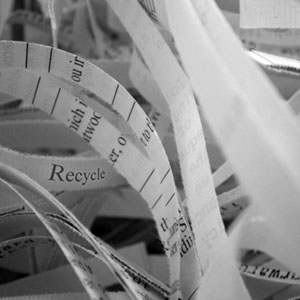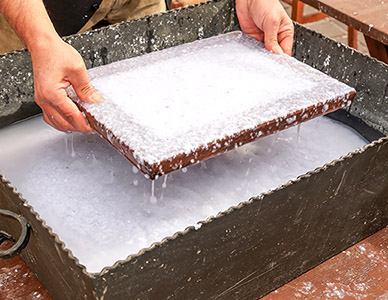
Unfortunately, we live in a time when identity theft is a real concern. To protect your identity, you may spend a great deal of time shredding documents that contain your personal data: name, address, social security number, date of birth, drivers license number and/or credit card information. However, after shredding your important documents, you are left with a pile of paper pieces.
You probably would put the shredded paper in your recycle bin and place it curbside for pickup – as you would your other paper recyclables. You figure now your tasks are done, you've protected your identity and helped the environment by recycling. But recycling is more than just putting items in the cart – you must recycle right! Recycling facilities use massive screens to process paper recyclables. Because shredded papers have been reduced to small pieces, they don't stick to the massive screens and fall through, which results in recycling machines becoming jammed. Shredded paper also creates a dust that is hazardous for workers.

A better way to help the environment and protect your identity is to avoid shredding documents when possible. You can redact or mark out your personal information using a permanent black marker before putting them in your recycle bin. Once your personal information is covered up, you can recycle it as you would your other paper recyclables. However, if you are more comfortable securing your sensitive documents by shredding, consider using a professional paper shredding company or saving up your documents for a city-wide shred day.
Professional shredding services will take the large bales of shredded paper they create to a mill for processing. Mills use a machine called a pulper. The pulper combines water and chemicals to break down the paper files, remove ink and any adhesives from the paper. The paper is rolled and dried and sent off to make new products.
Because the mixed-paper fibers of shredded paper are smaller than cardboard, newspaper or office paper, this paper is recycled into lesser-quality paper products such as coffee filters, egg cartons, or paper towels.
You might ask
I don't have enough paper for shredding to use a professional shredding company, but I want to secure my identity and protect the environment, what can I do?
You can Reuse your shredded paper.
Here are some ways to reuse your shredded paper:
Shredded documents are safe as compost, but avoid using colored paper and glossy paper in your compost bin. Shredded paper, placed in your compost bin, can be used like leaves as both provide carbon. Shredded paper is very useful during winter months when leaves are scarce. See our composting section for more information.


Place shredded paper in your litter box then put kitty litter on top. You don't have to use as much kitty litter, and the litter will still do its job.
Kids got a new hamster? Make a comfy bed for their pet using shredded paper.
Remember to contact your local veterinarian or animal shelter to see if they accept shredded paper to use for animals in their care.

Put your favorite essential oil on shredded paper and place them in a coffee filter. Tie with a ribbon and place under your pillow or give as gifts to friends.
Shredded paper is great to secure delicate items when packing for a move or just putting away in storage. Instead of using styrofoam or packing peanuts, try using shredded paper the next time you send someone a gift in the mail.
How do you use your shredded paper? Tell us on social media! @TimeToRecycle
Want to know more about Recycling? Check out "Know What To Throw" and take the Time To Recycle Quiz.